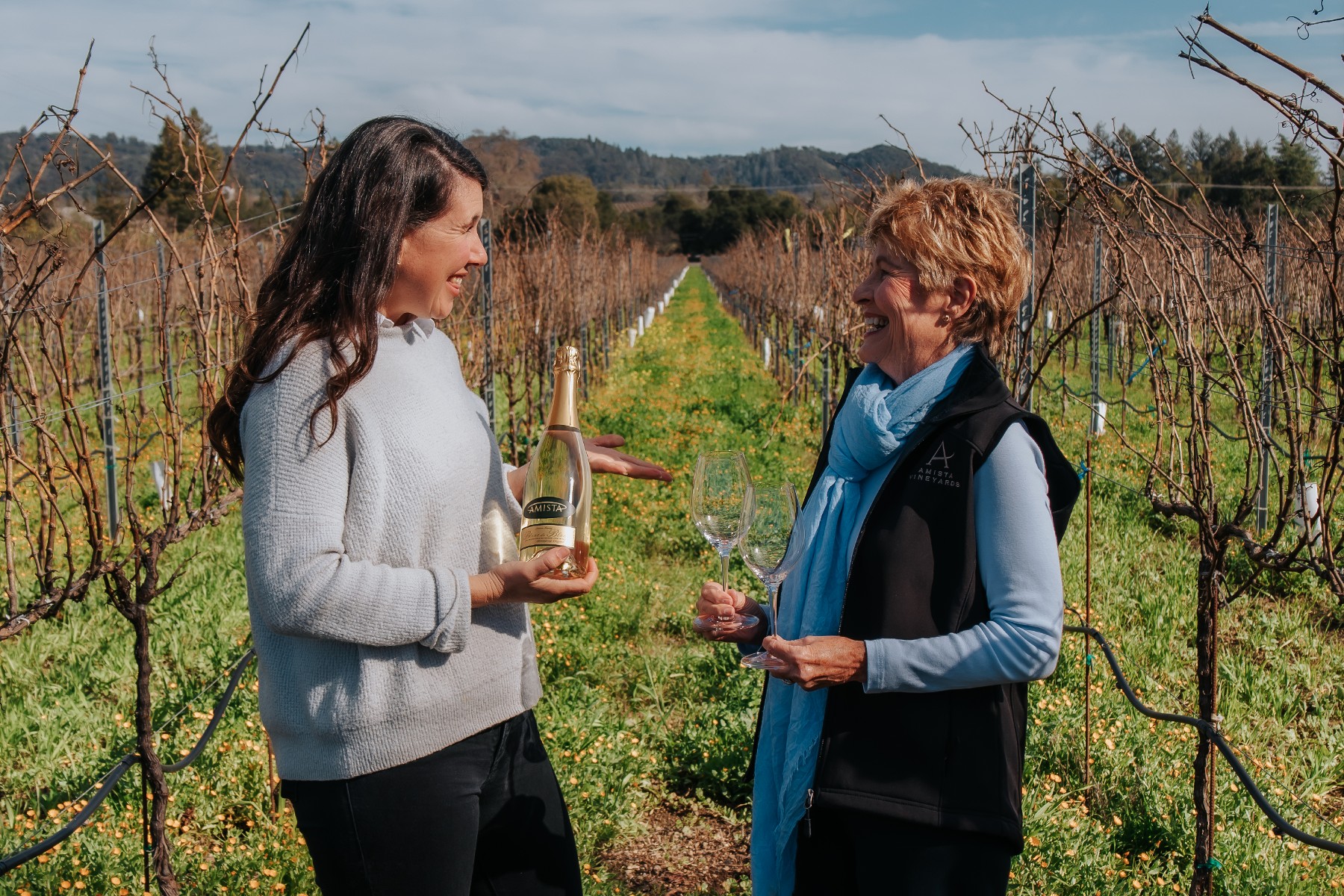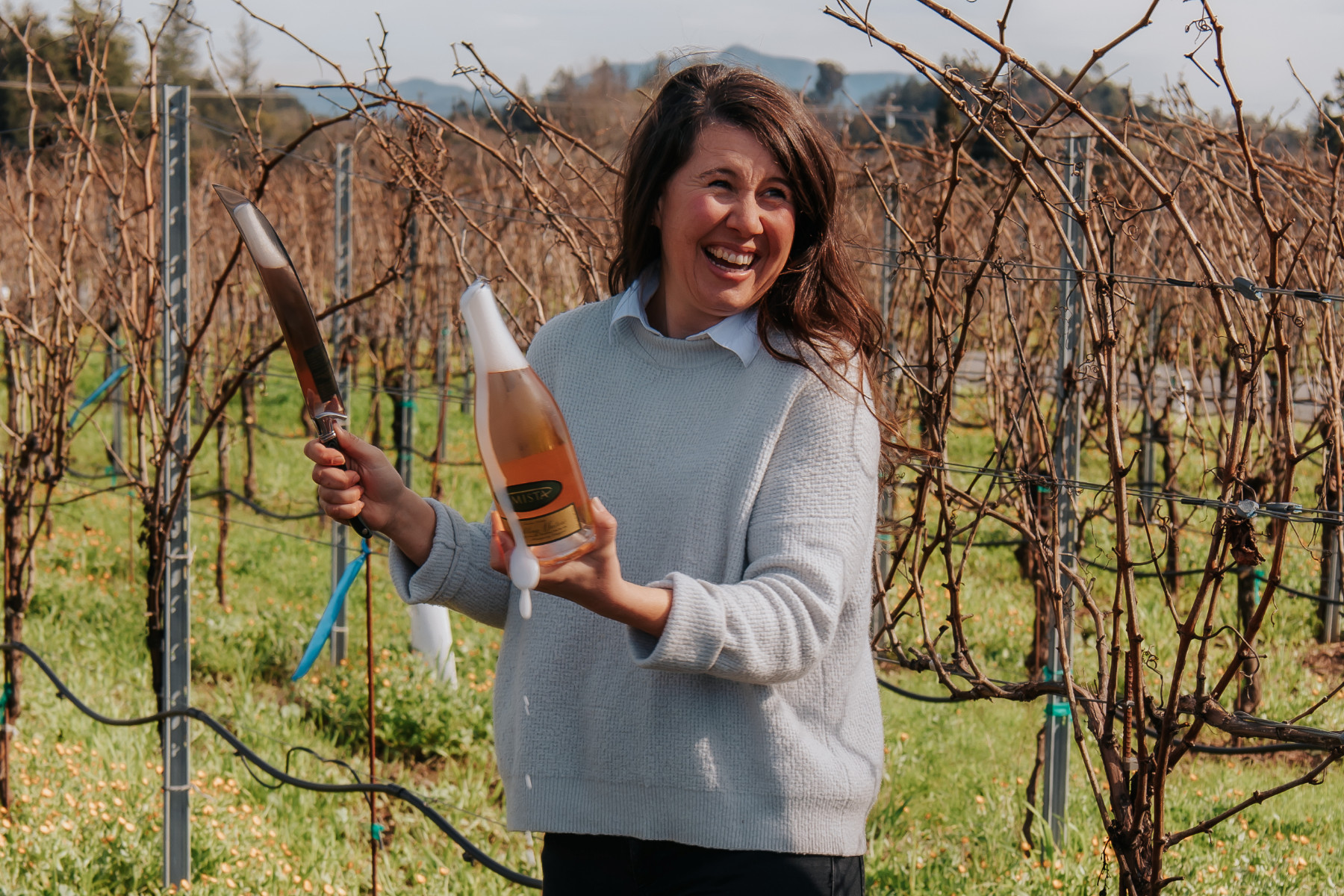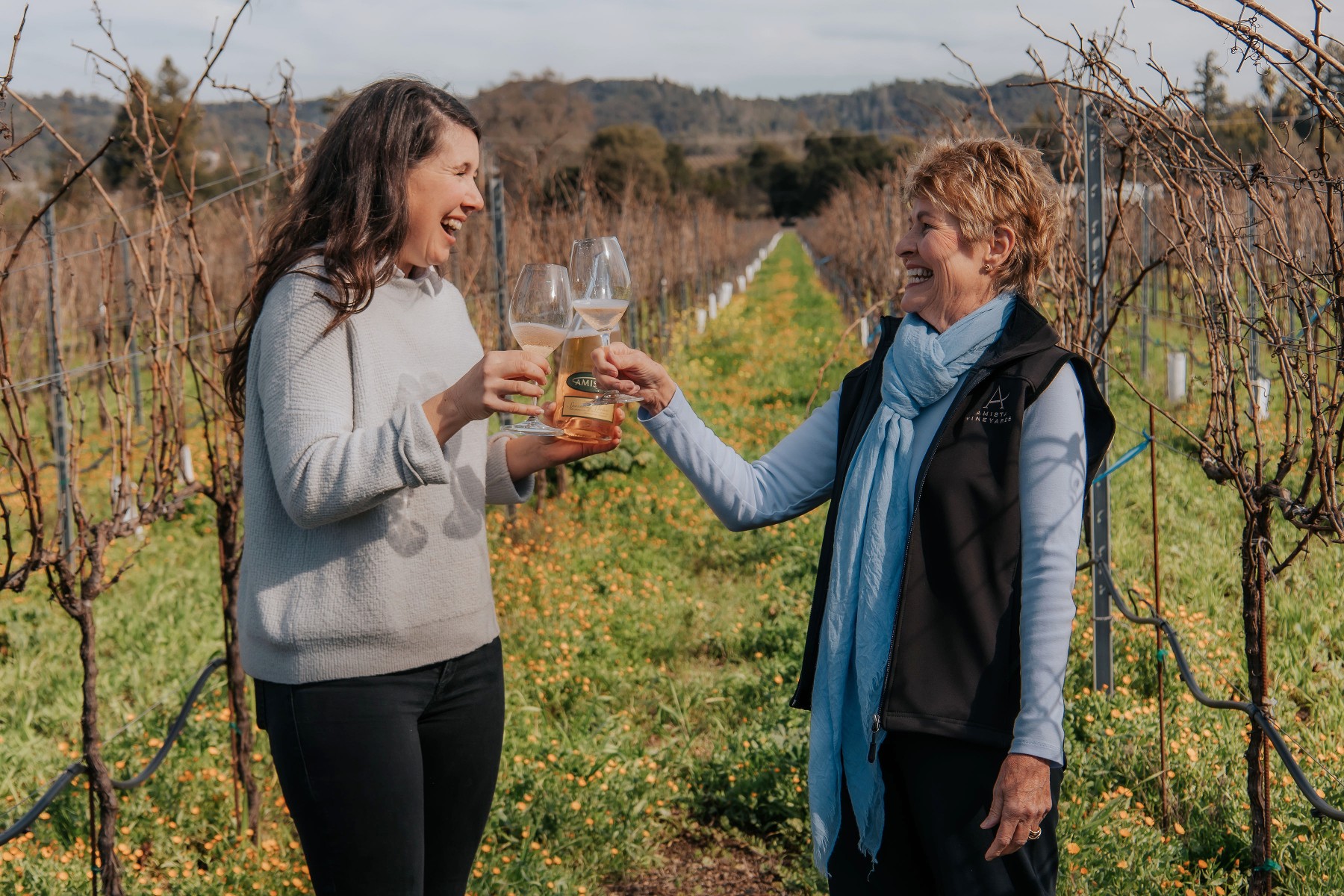News from Amista Vineyards
Amista Owner Vicky Farrow Profiled for International Womens Day

I am honored to be included in an article profiling women in wine for International Women’s Day, plus “the Wines We Are Toasting Them With” by Devin Parr. I’m even more excited to be toasted with a wine created by the women of Amista, our Blanc de Blanc.
A Sparkling Wine Created by the Women of Amista
What makes this wine extra special for toasting International Women’s Day is that it was created as the result of a spontaneous conversation between me and our newly hired woman winemaker, Ashley Herzberg, shortly after she arrived at Amista in 2011. We were standing in the Chardonnay vineyard one day and I asked her, “Do you think we could make a Blanc de Blanc from our Chardonnay?” She didn’t skip a beat when she answered, “Of course!” Mind you, she had not yet made a sparkling wine in her previous winemaking career. But, like me, she loves bubbles. Plus, Ashley is a woman who loves to learn and is always up for a new challenge.
Her First Sparkling Harvest
That fall, Ashley did her first harvest specifically to make a sparkling wine. She picked the grapes earlier than she would for a still wine to achieve lower sugar levels and thus lower alcohol, and higher levels of acid. She was nervous about how to know when the grapes would be ready to pick.
She got some sage advice from another woman winemaker, Penny Gadd-Coster, who had been making sparkling wines for over a decade. Penny told her, “You just still pick for flavors. You're shifting what you're looking for in those flavors. But you're still picking for flavors.” Ashley did just that and the inaugural release of our Amista Blanc de Blanc in 2013 scored 91 points and won a gold medal in the Press Democrat’s “Best of the Best” North Coast Wine Challenge.
Women Making Progress in Wine
As we toast to women in wine on International Women’s Day it’s worth celebrating that “Women have long been making strides in wine and, although the work is by no means done, it’s an exciting time to be a woman in the industry,” says Parr. She’s right.
A lot has changed over the years for women in wine. I have had the privilege of talking with several women involved in making sparkling wine as part of my project Sparkling Discoveries and there is a clear difference in the experiences of the young women of today as compared with the women who began their careers over two decades ago.
The trailblazing women who started their careers back then were consistently told they could not be winemakers because the work was too difficult for women. In my conversation with Eileen Crane, founding winemaker at Gloria Ferrer and Domaine Carneros, she told me that the first professor she met when she was exploring a degree in enology at Davis told her she couldn’t be a winemaker because she wouldn’t be able to do the work in the cellar. “You can’t handle the barrels,’ he told me. He suggested I finish my PhD in nutrition. I told him I’m not going to be doing that. I’m going to be a winemaker.” It took courage and determination to challenge such attitudes.
Today’s Challenges for Women in Wine are Different
The younger women working in wine today no longer face that kind of active opposition. Women are being encouraged to go into winemaking and wine business. They are celebrated, honored and recruited.
Challenges remain however, although they are less blatant. One has to do with the automatic assumption that the man is the winemaker or CEO. When a man and a woman are both pouring at a tasting, the questions about winemaking are typically directed to the man, although that appears to be changing. Kathleen Inman, Owner and Winemaker at Inman Family Wines, says, “I’ve noticed that people are less surprised to find out that I’m the winemaker, and not my husband, than they were 10 years ago.”
The other two challenges are pay equity and the presence of women in the most senior positions in wine businesses. A 2020 study by Wine Business Monthly shows 28.8% of the wineries had a female as Winemaking Director, although the average of the salaries for those females was 8% lower than the average for males. The same study shows 22% of winery CEOs were female but total cash compensation of the men was nearly double that of the women (1.95 times greater).
Inspiring Stories of Today's Women in Wine
So yes, there is still work to do. That is why it’s inspiring to read about examples of women with “extraordinary talent in wine” as described by Parr, and to hear what embracing equity means to each of them.
Read “15 (or so) Women We Are Toasting This International Women’s Day…And the Wines We Are Toasting Them With” by Devin Parr.
A Toast to Ashley Herzberg Next Generation Winemaker from Amista

“As the consulting winemaker for Amista Vineyards and Cast Wines, Ashley’s talents have produced many memorable wines. If you haven’t tried the Amista sparkling wine collection, be sure to stop by soon,” writes Rebecca Germolus in her article “A Toast to Women Winemakers.”
“In honor of Women’s History Month, let’s explore the paths of a few women winemakers along the Wine Road,” adds Germolus. If you are familiar with Sonoma County wine, you’ll know the names of the three women she features as pioneers, Carol Shelton, Julia Iantosca and Phyllis Zouzounis. Not only do they craft amazing wines, but they truly have been part of blazing the path for a future generation of women winemakers in Sonoma County. Rebecca proposes a toast to these pioneering women, saying, “A big thank you to Carol, Julia and Phyllis for staying the course.” We couldn’t agree more.
We are thrilled that Ashley is recognized as one of the next generation women shaping winemaking in Sonoma County. She is in good company on this list of other extremely talented female winemakers. She knows and interacts with all these women. That is one of the most wonderful things about Northern Sonoma County. There is a sense of connection, mutual support and admiration that permeates our wine community. By the way, men are not excluded, although I suspect the bond with other women is something extra special.
One of the ways Ashley stands out is making sparkling wines. Only a handful of winemakers in Sonoma County can make that claim plus Ashley is equally talented at crafting still wines. Her focus at Amista is on creating elegant, approachable sparkling wines from varieties that are not traditional - Rhône varieties - though she uses the traditional method, the same process that is used to make French Champagne. She is currently making six sparkling wines for Amista, all grown in our estate vineyards, and has another fermenting in the bottle to be released in 2024 to celebrate our 20th anniversary.
If you haven’t tried her sparkling wines or need to treat yourself again, we invite you to Taste With Us and toast to the women winemakers along the wine road.
Read “A Toast to Women Winemakers,” by Rebecca Germolus.
Celebrating Sparkling Women in History
From Veuve Clicquot to Amista’s Ashley Herzberg

…a toast to the women of sparkling – past and present
I just read an excellent article titled “How three widows came to rule Champagne” about the women who created some of Champagne’s most lauded empires. Although women were restricted from owning a business without the permission of their husband or father in 19th century France, widows were exempt from this rule.
Female Ingenuity in Champagne
“Some of the biggest innovations of Champagne came down to the ingenuity of several women…Barbe-Nicole Clicquot-Ponsardin, Louise Pommery and Lily Bollinger – among others – to turn vineyards into empires and ultimately transform the Champagne industry, permanently changing how it's made and marketed,” writes Lily Radziemski in BBC.com's World’s Table.
Bold Actions by Three Widows
It is good to be reminded of some of the bold actions of these three Champagne widows such as running the blockade into Russia to beat her biggest competitor to market before the borders opened, dramatically reducing the dosage (residual sugar) in her Champagne from the typical 300 grams per liter to what is now called Brut (12 grams or less) to appeal to the British market, or traveling alone across the U.S. to hand sell her Champagne to the American market.
Drawing Inspiration from Women's History Month
I’m inspired by these women who ignored what was considered acceptable for women at the time and daringly stepped in to manage and ultimately transform the businesses they inherited. “The independence and creativity of the three widows paved the way for generations of women to come,” explains Radziemski.
Paving the Way for Today's Women in Sparkling
The conversations I have with women leaders in sparkling wine prove her point. I continue to be inspired by the women who are blazing new trails in today’s business world. I enjoy the great privilege of having in-depth conversations with some of today’s female leaders in sparkling wine through my new project, Sparkling Discoveries. [We include men as well, but given that March is Women’s History Month, my focus is on women in this post].
Eileen Crane was hired as the winemaker for Gloria Ferrer, the first sparkling winery in Carneros, and discovered that in addition to making the wines, she would be responsible for constructing the winery and visitor center and launching the new brand. She went on to lead Domaine Carneros, starting one of the first wine clubs, pioneering the installation of solar at a winery and practicing “open book management.”
Penny Gadd-Coster became a sparkling winemaker after two previous careers – one in research and the other in hospital emergency rooms. She was told countless times that she could never become a winemaker because, “People didn’t think women should be in the cellar. The work was too physical,” explains Penny. She went on to be the Executive Director of Winemaking at Rack and Riddle, a custom wine services operation that produces wines for hundreds of sparkling wine houses.
Joy Sterling, owner of Iron Horse Vineyards, had a successful career in broadcast journalism until on her 10th anniversary she abruptly quit her job and moved to Sonoma County with no plan and no experience, to join her family’s sparkling wine business. She has become a master at creating new sparkling wines, often contributing part of the proceeds to causes that are dear to her heart such as the Marine Mammal Center (Ocean Reserve) and Redwood Empire Food Bank (Gratitude).
And speaking of close to the heart, I am fortunate to work alongside our woman winemaker at Amista, Ashley Herzberg, for the last 12 years and counting! She a trailblazer when it comes to winemaking, being the first woman to make a “grower sparkling wine” in Dry Creek Valley. She also manages to juggle being a busy winemaker, harvesting from multiple vineyards, working in several production facilities, making still and sparkling wines and attending numerous wine events, with being a dedicated mom to her two children. I am especially inspired by how she weaves together her work, her family, her friends and her community into a seamless life of constant learning, passion and delight.
Ashley and I are honored and proud to be part of a growing community of wineries in Sonoma County that are female led with female winemakers.
Read “How three widows came to rule Champagne”
Check out more Sparkling Conversations with other interesting people from the world of sparkling wine.